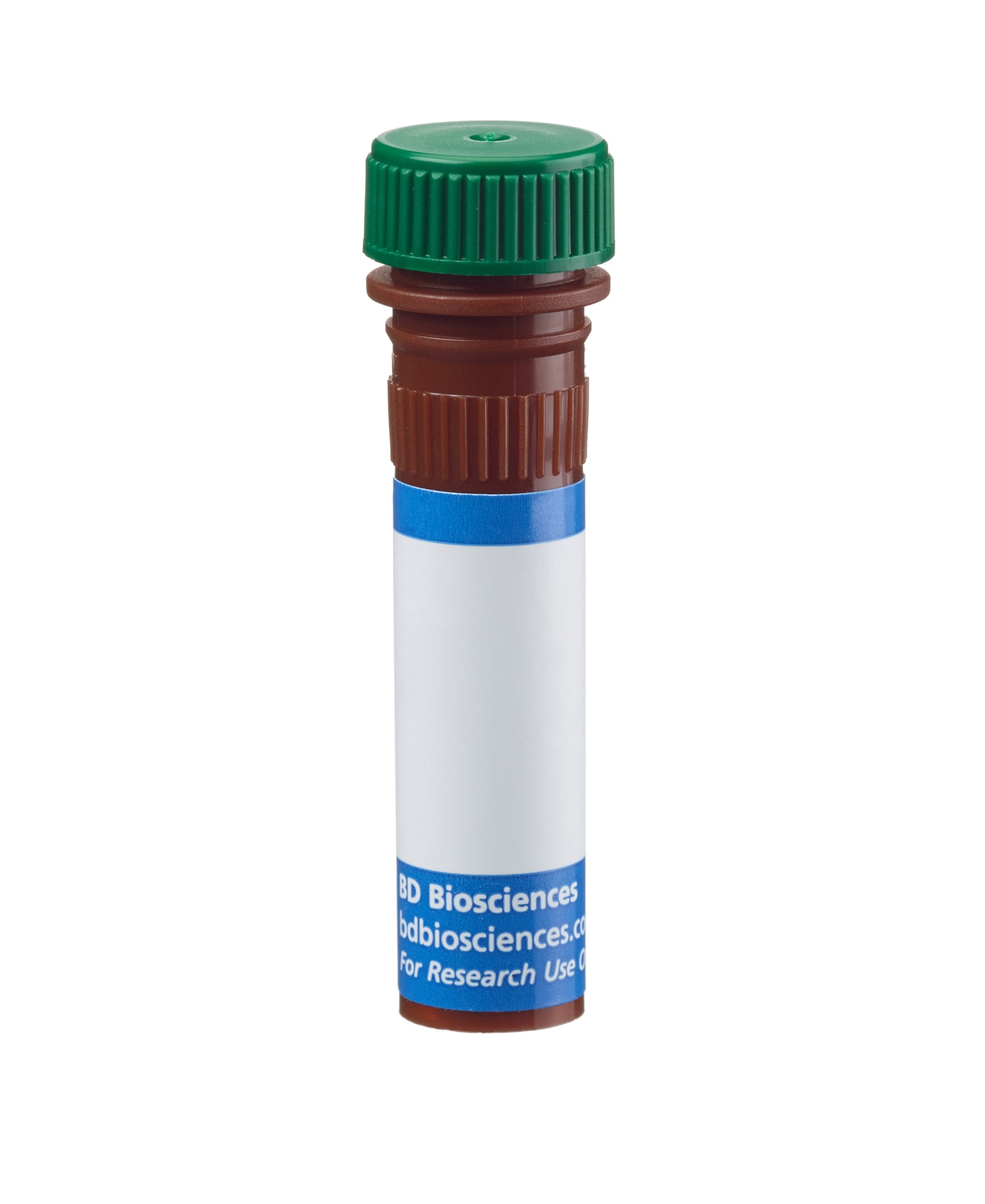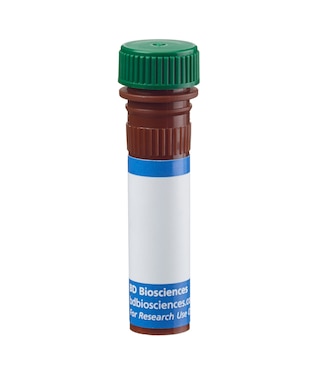Old Browser
Looks like you're visiting us from {countryName}.
Would you like to stay on the current country site or be switched to your country?




Two-color flow cytometric analysis of CD23 expression on human peripheral blood lymphocytes - Staining comparisons between BD Horizon™ BB515- and FITC-conjugated antibodies. Human whole blood was stained with APC Mouse Anti-Human CD19 antibody (Cat. No. 555415/ 561742) and either BD Horizon BB515 Mouse IgG1, κ Isotype Control (Cat. No. 564416; Left Panel) or BD Horizon BB515 Mouse Anti-Human CD23 antibody (Cat. No. 564555; Middle Panel). For comparison, cells were stained with APC Anti-Human CD19 and FITC Anti-Human CD23 (Cat. No. 561146; Right Panel) antibodies. Erythrocytes were lysed with BD FACS Lysing Solution (Cat. No. 349202). Two-color flow cytometric dot plots showing the correlated expression of CD23 (or Ig Isotype control staining) versus CD19 were derived from gated events with the forward and side light- scatter characteristics of intact lymphocytes. Flow cytometric analysis was performed using a BD™ LSR II Flow Cytometer System.


BD Horizon™ BB515 Mouse Anti-Human CD23

Regulatory Status Legend
Any use of products other than the permitted use without the express written authorization of Becton, Dickinson and Company is strictly prohibited.
Preparation And Storage
Recommended Assay Procedures
For optimal results, it is recommended to perform 2 washes after staining with antibodies. Cells may be prepared, stained with antibodies and washed twice with wash buffer per established protocols for immunofluorescent staining, prior to acquisition on a flow cytometer. Performing fewer than the recommended wash steps may lead to increased spread of the negative population.
Product Notices
- This reagent has been pre-diluted for use at the recommended Volume per Test. We typically use 1 × 10^6 cells in a 100-µl experimental sample (a test).
- An isotype control should be used at the same concentration as the antibody of interest.
- Caution: Sodium azide yields highly toxic hydrazoic acid under acidic conditions. Dilute azide compounds in running water before discarding to avoid accumulation of potentially explosive deposits in plumbing.
- The manufacture, use, sale, offer for sale, or import of this product is subject to one or more patents or pending applications. This product, and only in the amount purchased by buyer, may be used solely for buyer’s own internal research, in a manner consistent with the accompanying product literature. No other right to use, sell or otherwise transfer (a) this product, or (b) its components is hereby granted expressly, by implication or by estoppel. Diagnostic uses require a separate license.
- For fluorochrome spectra and suitable instrument settings, please refer to our Multicolor Flow Cytometry web page at www.bdbiosciences.com/colors.
- Please refer to www.bdbiosciences.com/us/s/resources for technical protocols.
Companion Products






The M-L233 antibody specifically binds to human CD23, the low affinity receptor for human IgE (FcεRII). CD23 is a type II membrane glycoprotein that is expressed by B cells, monocytes, macrophages, eosinophils, platelets and dendritic cells. CD23 mediates IgE-dependent cytotoxicity and phagocytosis by macrophages and eosinophils. Soluble CD23 (sCD23) can be released by CD23-positive cells as a result of proteolytic cleavage of membrane CD23. Larger fragments of sCD23 (e.g., 25-37 kDa) retain their IgE-binding capacity whereas smaller fragments (ie, ≤ 12 kDa) do not. Soluble CD23 may have immunoregulatory effects on the growth and differentiation of B cells and other cell types.
The antibody was conjugated to BD Horizon BB515 which was developed exclusively by BD Biosciences. With an excitation max of 490 nm and an emission max of 515 nm, BD Horizon BB515 can be excited by the 488 nm laser and detected in a standard FITC set (eg, 530/30-nm filter). This dye provides a much brighter alternative to FITC with less spillover into the PE detector.

Development References (6)
-
Belleau JT, Gandhi RK, McPherson HM, Lew DB. Research upregulation of CD23 (FcepsilonRII) expression in human airway smooth muscle cells (huASMC) in response to IL-4, GM-CSF, and IL-4/GM-CSF. Clin Mol Allergy. 2005; 3(6):1-12. (Clone-specific: Flow cytometry, Immunofluorescence, Western blot). View Reference
-
Delespesse G, Hofstetter H, Sarfati M. Low-affinity receptor for IgE (FcERII, CD23) and its soluble fragments. Int Arch Allergy Immunol. 1989; 90(1):41-44. (Biology). View Reference
-
Gordon J, Millsum MJ, Flores-Romo L, Gillis S. Regulation of resting and cycling human B lymphocytes via surface IgM and the accessory molecules interleukin-4, CD23 and CD40. Immunology. 1989; 68(4):526-531. (Biology). View Reference
-
Rieber EP, Rank G, Kohler I, Krauss S. Membrane expression of Fc epsilon RII/CD23 and release of soluble CD23 by follicular dendritic cells. Adv Exp Med Biol. 1993; 329:393-398. (Biology). View Reference
-
Saeland S, Duvert V, Moreau I, Banchereau J. Human B cell precursors proliferate and express CD23 after CD40 ligation. J Exp Med. 1993; 178(1):113-120. (Biology). View Reference
-
Sarfati M, Ishihara H, Delespesse G. CD23 Workshop Panel report. In: Schlossman SF. Stuart F. Schlossman .. et al., ed. Leucocyte typing V : white cell differentiation antigens : proceedings of the fifth international workshop and conference held in Boston, USA, 3-7 November, 1993. Oxford: Oxford University Press; 1995:530-533.
Please refer to Support Documents for Quality Certificates
Global - Refer to manufacturer's instructions for use and related User Manuals and Technical data sheets before using this products as described
Comparisons, where applicable, are made against older BD Technology, manual methods or are general performance claims. Comparisons are not made against non-BD technologies, unless otherwise noted.
For Research Use Only. Not for use in diagnostic or therapeutic procedures.
Report a Site Issue
This form is intended to help us improve our website experience. For other support, please visit our Contact Us page.